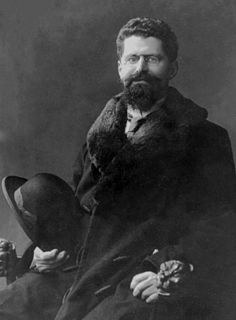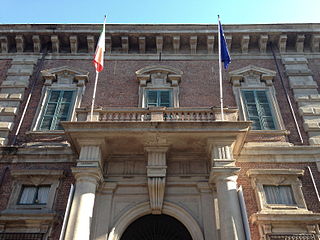
Gregorio Ricci-Curbastro was an Italian mathematician born in Lugo di Romagna. He is most famous as the inventor of tensor calculus, but also published important works in other fields.

The Accademia di Belle Arti di Firenze is an instructional art academy in Florence, in Tuscany, in central Italy.

Francesco Severi was an Italian mathematician.

Palazzo Brera or Palazzo di Brera is a monumental palace in Milan, in Lombardy in northern Italy. It was a Jesuit college for two hundred years. It now houses several cultural institutions including the Accademia di Brera, the art academy of the city, and its gallery, the Pinacoteca di Brera; the Orto Botanico di Brera, a botanical garden; an observatory, the Osservatorio Astronomico di Brera; the Istituto Lombardo Accademia di Scienze e Lettere, a learned society; and an important library, the Biblioteca di Brera.

The Accademia di Belle Arti di Bologna is a public tertiary academy of fine art in Bologna, in Emilia-Romagna in northern Italy. It has a campus in Cesena.

Prince Baldassarre Boncompagni-Ludovisi, was an Italian historian of mathematics and aristocrat.
Lamberto Cesari was an Italian mathematician naturalized in the United States, known for his work on the theory of surface area, the theory of functions of bounded variation, the theory of optimal control and on the stability theory of dynamical systems: in particular, by extending the concept of Tonelli plane variation, he succeeded in introducing the class of functions of bounded variation of several variables in its full generality.

Antonio Signorini was an influential Italian mathematical physicist and civil engineer of the 20th century. He is known for his work in finite elasticity, thermoelasticity and for formulating the Signorini problem.

Guido Zappa was an Italian mathematician and a noted group theorist: his other main research interests were geometry and also the history of mathematics. Zappa was particularly known for some examples of algebraic curves that strongly influenced the ideas of Francesco Severi.

The Accademia Galileiana, or "Galilean academy", is a learned society in the city of Padua in Italy. The full name of the society is Accademia galileiana di scienze, lettere ed arti in Padova, "Galilean academy of science, letters and the arts in Padova". It was founded as the Accademia dei Ricovrati in Padua in 1599, on the initiative of a Venetian nobleman, Federico Cornaro. The original members were professors in the University of Padua such as professor Georgios Kalafatis; one of its original members was Galileo Galilei. In 1779 the academy merged with the Accademia di Arte Agraria and became the Accademia di Scienze Lettere e Arti; in 1949 it became the Accademia Patavina di Scienze, Lettere ed Arti; its name was changed to Accademia Galileiana di Scienze, Lettere ed Arti in Padova in 1997, in honor of Galileo. The academy is lodged in the Carraresi Palace in Padua.
Accademia often refers to:
Dionigi Galletto was an Italian mathematician and academician.

Benedetto Servolini was an Italian painter, mainly of historical subjects.
Dario Graffi was an influential Italian mathematical physicist, known for his researches on the electromagnetic field, particularly for a mathematical explanation of the Luxemburg effect, for proving an important uniqueness theorem for the solutions of a class of fluid dynamics equations including the Navier-Stokes equation, for his researches in continuum mechanics and for his contribution to oscillation theory.

The Istituto Veneto di Scienze, Lettere ed Arti (IVSLA) is an academy of sciences in Venice.
Carlo Miranda was an Italian mathematician, working on mathematical analysis, theory of elliptic partial differential equations and complex analysis: he is known for giving the first proof of the Poincaré–Miranda theorem, for Miranda's theorem in complex analysis, and for writing an influential monograph in the theory of elliptic partial differential equations.
Gianfranco Cimmino was an Italian mathematician, working mathematical analysis, numerical analysis, and theory of elliptic partial differential equations: he is known for being the first mathematician generalizing in a weak sense the notion of boundary value in a boundary value problem, and for doing an influential work in numerical analysis.
Pietro Ermini (1774–1850) was an Italian painter and engraver, active in Florence.
Pietro Petrini was an Italian painter in Florence.
The Istituto Lombardo Accademia di Scienze e Lettere is an Italian academy founded by Napoleon in 1797. At the time of the foundation the Istituto was an institution of the Cisalpine Republic and its name was Istituto Nazionale della Repubblica Cisalpina.
This page is based on this
Wikipedia article Text is available under the
CC BY-SA 4.0 license; additional terms may apply.
Images, videos and audio are available under their respective licenses.










